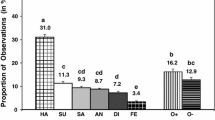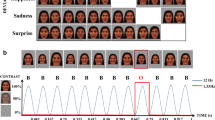Summary
Subjects were asked to decide whether or not simultaneously presented photographs of pairs of faces were pictures of the same person or of different people (identity matching), or to decide whether or not the pairs of face showed the same expressions or different expressions (expression matching). Faces of familiar and unfamiliar people were used as stimuli. For identity matching, reaction times to familiar faces were faster than reaction times to unfamiliar faces, but there was no difference between familiar and unfamiliar faces for expression matching. These results support the view derived from neuropsychological and neurophysiological studies that analyses of facial expressions proceed independently from processes involved in establishing the person's identity.
Similar content being viewed by others
References
Benton, A.L. (1980). The neuropsychology of facial recognition. American Psychologist, 35, 176–186.
Blanc-Garin, J. (1984). Perception des visages et reconnaissance de la physionomie dans l'agnosie des visages. L'Année Psychologique, 84, 573–598.
Bodamer, J. (1947). Die Prosop-Agnosie. Archiv für Psychiatrie und Nervenkrankheiten, 179, 6–53.
Bornstein, B. (1963). Prosopagnosia. In L. Halpern (Ed.), Problems of Dynamic Neurology. (pp. 283–318). Jerusalem: Hadassah Medical School.
Bowers, D., Bauer, R.M., Coslett, H.B., & Heilman, K.M. (1985). Processing of faces by patients with unilateral hemisphere lesions: 1. Dissociation between judgements of facial affect and facial identity. Brain and Cognition, 4, 258–272.
Bruce, C., Desimone, R., & Gross, C.G. (1981). Visual properties of neurons in a polysensory area in superior temporal sulcus of the macaque. Journal of Neurophysiology, 46, 369–384.
Bruce, V. (1979). Searching for politicians: an information-processing approach to face recognition. Quarterly Journal of Experimental Psychology, 31, 373–395.
Bruce, V. (1982). Changing faces: visual and non-visual coding processes in face recognition. British Journal of Psychology, 73, 105–116.
Bruce, V. (1983). Recognizing faces. Philosophical Transactions of the Royal Society, London: Series B, 302, 423–436.
Bruce, V., & Valentine, T. (1985). Identity priming in the recognition of familiar faces. British Journal of Psychology, 76, 373–383.
Bruce, V., & Young, A.W. (1986). Understanding face recognition. British Journal of Psychology, 77
Bruyer, R., Laterre, C., Seron, X., Feyereisen, P., Strypstein, E., Pierrard, E., & Rectem, D. (1983). A case of prosopagnosia with some preserved covert remembrance of familiar faces. Brain and Cognition, 2, 257–284.
Calis, G., & Mens, L. (1986). Primary stages in single-glance face recognition: expression and identity. In H.D. Ellis, M.A. Jeeves, F. Newcombe and A.W. Young (Eds.), Aspects of Face Processing. Dordrecht: Martinus Nijhoff
Campbell, R., & Dodd, B. (1980). Hearing by eye. Quarterly Journal of Experimental Psychology, 32, 85–99.
Cicone, M., Wapner, W., & Gardner, H. (1980). Sensitivity to emotional expression and situations in organic patients. Cortex, 16, 145–158.
Desimone, R., Albright, T., Gross, C.G., & Bruce, C. (1984). Stimulus-selective properties of inferior temporal neurons in the macaque. Journal of Neuroscience, 4, 2051–2062.
Ekman, P. & Oster, H. (1979). Facial expressions of emotion. Annual Review of Psychology, 30, 527–554.
Ellinwood, E.H. (1969). Perception of faces. Psychiatric Quarterly, 43, 622–646.
Ellis, H.D. (1983). The role of the right hemisphere in face perception. In A.W. Young (Ed.), Functions of the Right Cerebral Hemisphere. (pp. 33–64) London: Academic Press.
Ellis, H.D. (1986). Processes underlying face recognition. In R. Bruyer (Ed.), The Neuropsychology of Face Perception and Facial Expression. New Jersey: Erlbaum.
Ellis, H.D., Shepherd, J.W., & Davies, G.M. (1979). Identification of familiar and unfamiliar faces from internal and external features: some implications for theories of face recognition. Perception, 8, 431–439.
Endo, M., Takahashi, K., & Maruyama, K. (1984). Effects of observer's attitude on the familiarity of faces: using the difference in cue value between central and peripheral facial elements as an index of familiarity. Tohoku Psychologica Folia, 43, 23–34
Etcoff, N.L. (1984). Selective attention to facial identity and facial emotion. Neuropsychologia, 22, 281–295.
Etcoff, N.L. (1985). The neuropsychology of emotional expression. In G. Goldstein & R.E. Tarter (Eds.), Advances in Clinical Neuropsychology 3. New York: Plenum.
Hansch, E.C., & Pirozzolo, F.J. (1980). Task relevant effects on the assessment of cerebral specialization for facial emotion. Brain and Language, 10, 51–59.
Hay, D.C., & Young, A.W. (1982). The human face. In A.W. Ellis (Ed.). Normality and Pathology in Cognitive Functions. (pp. 173–202). London: Academic Press.
Hay, D.C., Young, A.W., & Ellis, A.W. (1986). What happens when a face rings a bell? Automatic processing of famous faces. In H.D. Ellis, M.A. Jeeves, F. Newcombe, & A.W. Young (Eds.), Aspects of Face Processing. Dordrecht: Martinus Nijhoff.
Hécaen, H. (1981). The neuropsychology of face recognition. In G. Davies, H. Ellis, & J. Shepherd (Eds.). Perceiving and Remembering Faces. (pp. 39–54). London: Academic Press.
Klatzky, R.L., & Forrest, F.H. (1984). Recognizing familiar and unfamiliar faces. Memory and Cognition, 12, 60–70.
Kurucz, J., & Feldmar, G. (1979). Prosopo-affective agnosia as a symptom of cerebral organic disease. Journal of the American Geriatrics Society, 27, 225–230.
Kurucz, J., Feldmar, G., & Werner, W. (1979). Prosopo-affective agnosia associated with chronic organic brain syndrome. Journal of the American Geriatrics Society, 27, 91–95.
Ley, R.G., & Bryden, M.P. (1979). Hemispheric differences in processing emotions and faces. Brain and Language, 7, 127–138.
MacDonald, J., & McGurk, H. (1978). Visual influences on speech perception processes. Perception and Psychophysics, 24, 253–257.
McGurk, H., & MacDonald, J. (1976). Hearing lips and seeing voices. Nature, 264, 746–748.
Malone, D.R., Morris, H.H., Kay, M.C., & Levin, H.S. (1982). Prosopagnosia: a double dissociation between the recognition of familiar and unfamiliar faces. Journal of Neurology, Neurosurgery, and Psychiatry, 45, 820–822.
Newcombe, F. (1979). The processing of visual information in prosopagnosia and acquired dyslexia: functional versus physiological interpretation. In D.J. Oborne, M.M. Gruneberg, & J.R. Eiser (Eds.) Research in Psychology and Medicine, Vol 1. (pp. 315–322). London: Academic Press.
Perrett, D.I., Rolls, E.T., & Caan, W. (1982). Visual neurones responsive to faces in the monkey temporal cortex. Experimental Brain Research, 47, 329–342.
Perrett, D.I., Smith, P.A.J., Potter, D.D., Mistlin, A.J., Head, A.S., Milner, A.D., & Jeeves, M.A. (1984). Neurones responsive to faces in the temporal cortex: studies of functional organization, sensitivity to identity and relation to perception. Human Neurobiology, 3, 197–208.
Perrett, D.I., Smith, P.A.J., Potter, D.D., Mistlin, A.J., Head, A.S., Milner, A.D., & Jeeves, M.A., (1985). Visual cells in the temporal cortex sensitive to face view and gaze direction. Proceedings of the Royal Society, London, B223, 293–317.
Perrett, D.I., Mistlin, A.J., Potter, D.D., Smith, P.A., Head, A.S., Chitty, A.J., Broennimann, R., Milner, A.D., & Jeeves, M.A. (1986). Functional organization of visual neurones processing face identity. In H.D. Ellis, M.A. Jeeves, F. Newcombe, & A.W. Young (Eds.), Aspects of Face Processing. Dordrecht: Martinus Nijhoff.
Pizzamiglio, L., Zoccolotti, P., Mammucari, A., & Cesaroni, R. (1983). The independence of face identity and facial expression recognition mechanisms: relationship to sex and cognitive style. Brain and Cognition, 2, 176–188.
Rhodes, G. (1985). Lateralized processes in face recognition. British Journal of Psychology, 76, 249–271.
Rolls, E.T. (1984). Neurons in the cortex of the temporal lobe and in the amygdala of the monkey with responses selective for faces. Human Neurobiology, 3, 209–222.
Shuttleworth, E.C. Jr., Syring, V., & Allen, N. (1982). Further observations on the nature of prosopagnosia. Brain and Cognition, 1, 307–322.
Strauss, E., & Moscovitch, M. (1981). Perception of facial expressions. Brain and Language, 13, 308–332.
Suberi, M., & McKeever, W.F. (1977). Differential right hemispheric memory storage of emotional and non-emotional faces. Neuropsychologia, 15, 757–768.
Yin, R.K. (1970). Face recognition by brain-injured patients: a dissociable ability? Neuropsychologia, 8, 395–402.
Young, A.W. (1984). Right cerebral hemisphere superiority for recognising the internal and external features of famous faces. British Journal of Psychology, 75, 161–169.
Young, A.W., Hay, D.C., & Ellis, A.W. (1985). The faces that launched a thousand slips: everyday difficulties and errors in recognising people. British Journal of Psychology, 76, 495–523.
Young, A.W., Hay, D.C., & Ellis, A.W. (1986). Getting semantic information from familiar faces. In H.D. Ellis, M.A. Jeeves, F. Newcombe, & A.W. Young (Eds.), Aspects of Face Processing. Dordrecht: Martinus Nijhoff.
Young, A.W., Hay, D.C., McWeeny, K.H., & Ellis, A.W. (1986). Access to identity-specific semantic codes from familiar faces. Quarterly Journal of Experimental Psychology, 38A, 271–295.
Young, A.W., Hay, D.C., McWeeny, K.H., Flude, B.M., & Ellis, A.W. (1985). Matching familiar and unfamiliar faces on internal and external features. Perception, 14, 737–746.
Author information
Authors and Affiliations
Additional information
This research was supported by the ESRC (Grant C 0023 2075)
Rights and permissions
About this article
Cite this article
Young, A.W., McWeeny, K.H., Hay, D.C. et al. Matching familiar and unfamiliar faces on identity and expression. Psychol. Res 48, 63–68 (1986). https://doi.org/10.1007/BF00309318
Received:
Issue Date:
DOI: https://doi.org/10.1007/BF00309318




